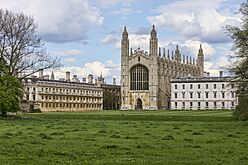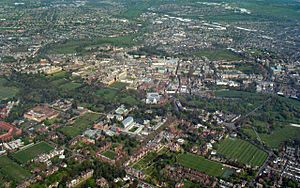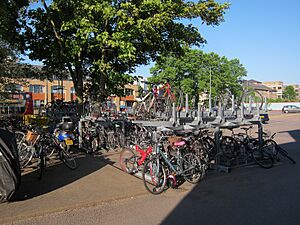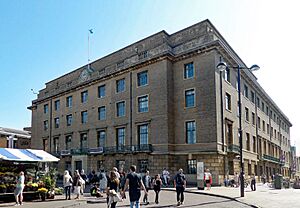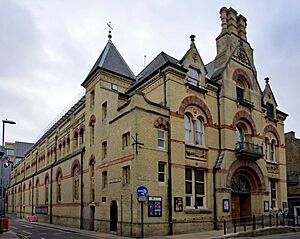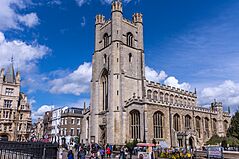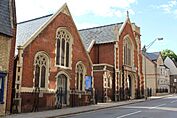Cambridge facts for kids
Quick facts for kids
Cambridge
|
||
|---|---|---|
|
City and non-metropolitan district
|
||
|
|
||
|
||

Cambridge shown within Cambridgeshire
|
||
| Sovereign state | United Kingdom | |
| Country | England | |
| Region | East of England | |
| County | Cambridgeshire | |
| City region | Cambridgeshire and Peterborough | |
| Founded | c. 1209 as Granta Brygg | |
| City status | 1951 | |
| Administrative HQ | Cambridge Guildhall | |
| Government | ||
| • Type | Non-metropolitan district | |
| • Body | Cambridge City Council | |
| Area | ||
| • Total | 15.71 sq mi (40.70 km2) | |
| Area rank | 288th | |
| Population
(2005 est.)
|
||
| • Total | 124,798 | |
| • Rank | 186th | |
| Demonym(s) | Cantabrigian | |
| Ethnicity (2021) | ||
| • Ethnic groups |
List
|
|
| Religion (2021) | ||
| • Religion |
List
44.7% no religion
35.2% Christianity 5.1% Islam 2.3% Hinduism 1.1% Buddhism 0.7% Judaism 0.2% Sikhism 0.8% other 9.8% not stated |
|
| Time zone | UTC+0 (GMT) | |
| • Summer (DST) | UTC+1 (BST) | |
| Postcode areas |
CB
|
|
| Dialling codes | 01223 | |
| GSS code | E07000008 | |
Cambridge (![]() i/ˈkeɪmbrɪdʒ/ KAYM-brij) is a famous city in England. It's located in the county of Cambridgeshire, right on the River Cam. The city is about 55 miles (88 km) north of London.
i/ˈkeɪmbrɪdʒ/ KAYM-brij) is a famous city in England. It's located in the county of Cambridgeshire, right on the River Cam. The city is about 55 miles (88 km) north of London.
In 2021, about 145,700 people lived in Cambridge. The city has been an important trading spot since Roman and Viking times. People have lived here since the Bronze Age. Cambridge officially became a city in 1951.
Cambridge is most famous for being home to the University of Cambridge. This university was started in 1209. It is known as one of the best universities in the world. Important buildings include King's College Chapel and the Cambridge University Library. The city's skyline features many university buildings. Anglia Ruskin University also has its main campus in Cambridge.
The city is a hub for high-tech companies, often called Silicon Fen. These companies work in areas like software and bioscience. Many of them started at the university. A large number of people working in Cambridge have a university degree. The Cambridge Biomedical Campus is a huge centre for medical research.
Cambridge is also where the first rules for association football were made. The very first game was played at Parker's Piece. The city hosts fun events like the Strawberry Fair music festival. The annual Cambridge Beer Festival is held on Jesus Green.
History of Cambridge
Early Times
People have lived in the Cambridge area for thousands of years. The oldest signs of a settlement are from a 3,500-year-old farm. Later, during the British Iron Age, a village was built on Castle Hill.
Roman and Medieval Ages
The Romans built a small fort called Duroliponte on Castle Hill around AD 70. After the Romans left, Anglo-Saxons settled here. They called their village Grantebrycge, meaning "Granta-bridge." The River Cam got its name from this.
In 875, Vikings arrived and took control for a while. They were good traders, which helped the town grow. The town centre moved to the area now called the Quayside. After the Vikings, the Saxons built churches and a mint for coins.
In 1068, after the Norman Conquest, William the Conqueror built Cambridge Castle. Cambridge got its first town charter between 1120 and 1131. This gave the town special rights for trade.
The University of Cambridge was founded in 1209. Students from Oxford came here to escape problems there. The oldest college, Peterhouse, was started in 1284.
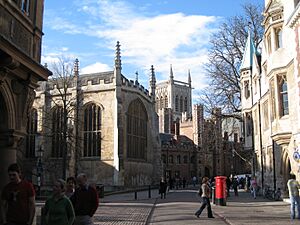
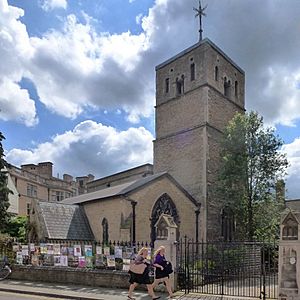
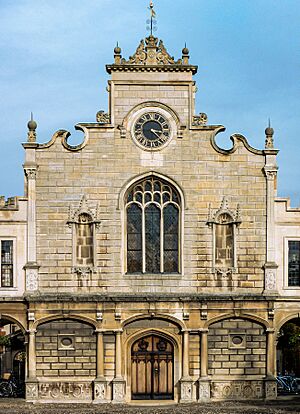
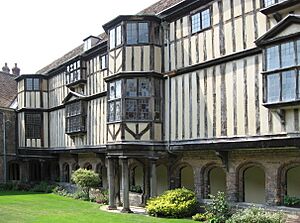
The Black Death hit Cambridge in 1349. Many people died, and some parts of the town were almost empty. After this, more colleges were built to train new clergy.
King's College Chapel was started in 1446 by King Henry VI. It took many years to build and is now a symbol of Cambridge.
Modern Cambridge
In the 1600s, Hobson's Conduit was built to bring fresh water to Cambridge. This helped with cleanliness and health.
During the English Civil War, Cambridge was an important base for Oliver Cromwell and his army. The town's castle was made stronger, but it was never attacked.
In the 1800s, Cambridge grew quickly. The railway arrived in 1845, connecting the city to London. This brought new jobs and industries.
Cambridge became an official city in 1951. It continued to grow with new housing areas. During World War II, Cambridge was a key defence centre. It was also a safe place for people from London to evacuate to. The city was not badly damaged by bombing.
In 1992, Anglia Polytechnic became Anglia Ruskin University, giving Cambridge a second university.
How Cambridge is Run
Cambridge has two main levels of local government. These are the Cambridge City Council and the Cambridgeshire County Council. These councils work together to manage the city and the wider county. The city council's main office is in the Cambridge Guildhall.
Cambridge also has two MPs who represent the city in the UK Parliament. They are Pippa Heylings and Daniel Zeichner.
Geography and Climate
Cambridge is located in a flat, low-lying area, just south of the Fens. The city is built around the River Cam, which flows through it. There are many green spaces like Sheep's Green and Jesus Green.
The city centre has many historic buildings and shops. Newer housing areas have been built as the city has grown.
Cambridge has an oceanic climate, meaning it has mild temperatures. It's one of the driest places in Britain, with less rain than the national average. Summers can be warm, and Cambridge often records some of the highest temperatures in the UK. Winters are generally mild, with little snow.
People of Cambridge
In 2011, the population of Cambridge was about 123,867 people. The city is very diverse, with people from many different backgrounds.
Cambridge has a high number of people working in professional or management jobs. Many residents have a university degree, much higher than the national average.
Cambridge's Economy
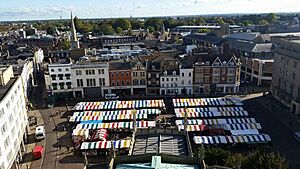
Historically, Cambridge was an important trading town because of its river links. The city's market and annual fairs were very busy.
Today, Cambridge has a strong and varied economy. It's known for research, software, engineering, and tourism. Many people consider Cambridge one of the "most beautiful cities in the world." Tourism brings in a lot of money for the city.
Cambridge is often called Silicon Fen. This is because it has many high-tech businesses and technology companies. Many of these companies started at the university. For example, Cambridge Science Park is owned by Trinity College. Big tech companies like ARM Limited and Microsoft Research have offices here.
Getting Around Cambridge
Cambridge is very flat, which makes it great for cycling. Many people in the city travel to work by bike.
Trains
Cambridge railway station opened in 1845. You can catch trains to London, Norwich, and other cities. A second station, Cambridge North, opened in 2017. A third station, Cambridge South, is being built near Addenbrooke's Hospital.
Roads
Major roads like the M11 motorway and A14 connect Cambridge to other parts of England. Traffic can be busy in the city centre.
Buses
Cambridge has five Park and Ride sites. These help people park their cars outside the city and take a bus in. The Cambridgeshire Guided Busway carries buses into the city centre from nearby towns.
Education in Cambridge
Cambridge is home to two universities. The University of Cambridge and Anglia Ruskin University teach around 30,000 students.
The city also has many schools for children of all ages. These include state schools like Chesterton Community College and private schools like The Perse School.
Sports in Cambridge
Football

Cambridge played a big part in creating modern association football. The first rules of the game were written here in 1848. They were first played on Parker's Piece.
The city has two main football clubs. Cambridge United play at the Abbey Stadium. They have played in the English Football League. Cambridge City now play in a nearby town.
Other Sports
- Cricket: The university's cricket ground, Fenner's, is in the city.
- Rugby: Cambridge has rugby union and rugby league clubs.
- Watersports: The River Cam is used for rowing and punting. Many rowing clubs are based here.
- Parkour: Cambridge is known for its active parkour and freerunning community.
Culture and Fun
Theatre and Music
The Cambridge Arts Theatre is the main traditional theatre. The Cambridge Corn Exchange hosts larger shows and concerts. The ADC Theatre is run by the university and features student performances.
Cambridge has a lively music scene. The band Pink Floyd has roots in the city. Many other bands and artists have come from Cambridge. The city hosts the annual Cambridge Music Festival.
Museums
Cambridge has several interesting museums.
- The Fitzwilliam Museum is the largest, with collections of art and ancient objects.
- The Polar Museum shows the history of polar exploration.
- The Sedgwick Museum of Earth Sciences has fossils and rocks.
- The Museum of Cambridge tells the story of local life.
- The Centre for Computing History explores the history of computers.
Festivals and Events
Cambridge hosts many festivals, especially in summer.
- Midsummer Fair is an old fair with a funfair.
- Strawberry Fair is a free music and children's fair.
- The Cambridge Beer Festival is held in May.
- The Cambridge Film Festival shows many independent films.
- The Cambridge Folk Festival is held every year at Cherry Hinton Hall.
- The Cambridge Science Festival is the UK's largest free science festival.
- The Cambridge Shakespeare Festival has open-air plays in college gardens.
Books and TV
Cambridge has been the setting for many novels. The TV series Granchester was partly filmed here.
Public Services
Cambridge is served by Addenbrooke's Hospital, a large teaching hospital. The city has its own police and fire stations. Libraries are run by the County Council.
Religion
Cambridge has many churches, including the famous Great St Mary's Church. Many university colleges also have their own chapels.
The city has a large Roman Catholic church, Our Lady and the English Martyrs Church. There are also Methodist churches and Quaker meeting houses.
Cambridge has an Orthodox synagogue and a Reform synagogue. The Cambridge Central Mosque, opened in 2019, is the main place of worship for Muslims. There are also Buddhist and Hindu centres, and a Sikh Gurdwara.
Twinned Cities
Cambridge is twinned with two other cities:
- Heidelberg, Germany (since 1965)
- Szeged, Hungary (since 1987)
Panoramic gallery
See also
 In Spanish: Cambridge para niños
In Spanish: Cambridge para niños


